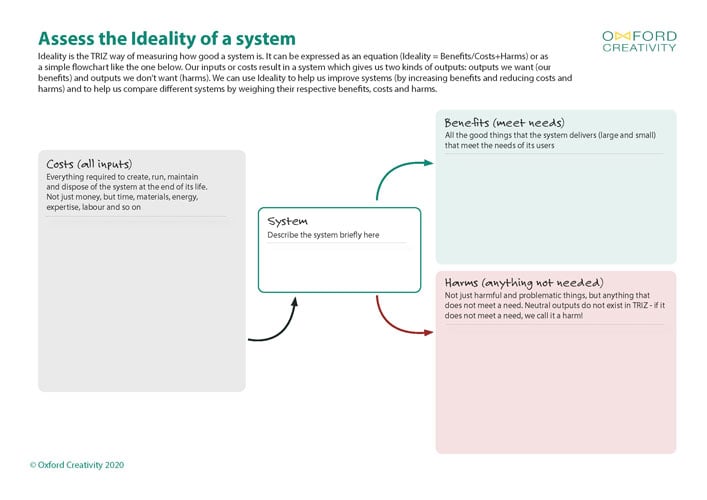There are three coronavirus vaccines that are currently in the process of being launched and made available to as many people as possible, as soon as possible. All of which claim to have about 90% effectiveness in preventing coronavirus, from early data clinical trials. We will need many vaccine options, but which one comes out best according to TRIZ?
At Oxford Creativity we know which vaccine we are rooting for … but as we are all rational, technical people we want to use the facts and our tried and tested TRIZ tools to logically compare the first three launched so far.
When we set about checking the Ideality of the Oxford Covid-19 vaccine against the Pfizer and Moderna vaccines, the results surprised us as we think there is a clear and obvious favourite at the moment. However, it's early days and as more results are known, and their relative merits and downsides revealed, we shall be updating our vaccine comparison using this amazing TRIZ tool of Ideality.
.jpg?width=2040&name=2169%20Health%20correspondent%20(col).jpg)
Oxford TRIZ is illustrated with Goddard cartoons
TRIZ Ideality helps us logically choose between options
Ideality is one of the best tools for assessing anything. We use it in every stage of problem solving, especially when deciding the routes forward. Ideality determines not just benefits, of systems and processes and what they cost to deliver, but also their harms /problems and any outputs we are paying for but don’t want or need. This simplest of measures enables fast but true comparison of competing solutions especially when the there are so many factors that it feels too complicated to call with confidence.

When we finish a problem solving session with an organisation, and have driven TRIZ through their teams’ experience to enable them to find for themselves several best (different) solutions – we then help them choose which ones to take forward. We do this is by undertaking an Ideality Audit to logically compare and assess their competing options, with their different merits, problems and costs /required inputs.
Like most of TRIZ the Ideality Audit is so simple and yet delivers so much understanding and clarity that I continue to be astonished how hard it has been to build acceptance and make it - and TRIZ - rightly popular.
The world is full of many management tools from simple to complex. Simple is usually easy to grasp but most don’t deliver much at all, whereas the complex ones give high yields but take a lot of input. TRIZ tools are both simple and deliver the high yields. When I started my MBA at London Business School my tutor from Imperial sent me a quick guide to management tools I should know, this included the good simple ones such as Fishbone, SWAT and 5 Whys. I had hoped much management training would not be a dominated by such obvious, age-old, simple techniques or by tools obscured in so much detail they are hard to understand and use. Sadly it was. After a degree in Mechanical Engineering and corporate planning for a bank I hoped an MBA would be transformational (it was in my cohort particularly in boosting confidence, salaries and egos).
I was disappointed but my disappointment set me on a road to uncover, learn and apply the correct logic and good rules to solve problems so I could successfully run an organisation (always small ones in my case). It was only when I found TRIZ did I know I had found the powerful, logical, tools and concepts the world needs to help us choose the best options for the future.

TRIZ delivers the fundamental truths of how to solve the right problem, locate the best, innovative solutions and achieve a clear understanding of situations by following simple patterns. Once you have the TRIZ Habits it is second nature to access your best brain power together with the relevant world knowledge. TRIZ has helped me in everything since then - except how to get it adopted, accepted and popular!
Measure Ideality NOT Value
Ideality has just three elements yet is so much broader than Value (valuable as it is). Ask anyone to choose between different systems and they will almost always describe them in terms of value or cost or worth. They don’t often distinguish their different meanings as Oscar Wilde witheringly observed: “Nowadays people know the price of everything and the value of nothing.” Assessing value (not cost) might be the moral here, but even definitions of value are flawed, contradictory and often incomplete or have so many elements we lose their meaning. Like many business tools there are various Value definitions, if you look up even the simplest definition you get a variety of incompatible answers, including:
Value = Function/Cost
Value = Price – Costs
Value = anything the customer wants
Value is described in so many ways that it is hard to be precise, therefore why not always use the all encompassing and accurate measure of Ideality?
Ideality is unambiguous – just three elements precisely defined as an equation so we know to increase Ideality we simply want more Benefits and/or less costs and harms.

Ideality is used when selecting objects, processes or systems which offer much choice and too many bewildering options. One important consideration is that you are selecting benefits – choose what you want most – don’t compromise. The TRIZ rule is to never dismiss the big things you want just because they have problems – problems can be solved. Always aim for what you really, really want no matter what the downsides. Try it when choosing anything from the small and mundane like shopping bags (plastic? bags for life? Compostable? Designer?) to the big choices like buying a car or house – assess and compare competing options through Ideality.

TRIZ encourages you to seek everything you want – even if there are contradictions
Can we compare Covid Vaccine systems with an Ideality Audit?
Although there are so many unknowns about Covid and the efficacy of its emerging vaccines if we assess the leading vaccines with Ideality we can make approximate yet clear comparisons. We simply compare the outputs we want (BENEFITS) against their required inputs (COSTS) plus any outputs we don’t want (HARMS).
One significant difference between the Covid vaccines is that although they have similar benefits they have very different costs and harms. If we compare the inputs needed to deliver it widely and quickly the differences are huge. For example to keep the vaccine stable two of the leading three require high inputs as they must be stored at very low temperatures. This means significant investment to provide the means of achieving this.
When there are problematic outputs of huge complexity, making distribution and storage difficult, and possibly unreliable – these may turn out even more significant than the unit price. Ideality makes these differences clear, even in the most approximate of assessments, to help us choose the system with the highest benefits and lowest costs and harms.
Some simple known hints and facts for Vaccine comparisons:
Benefits are outputs /things we (everyone) want(s) – benefits don’t tell us how we get something – they tell us only what we want. (How we get benefits is with functions and I despair when clever people mix them up. Knowing the difference is critical as much of TRIZ is devoted to getting the functions right and the right functions)
What Benefits do we want from a vaccine? IMMUNITY now and forever? Safety? Consistency
Costs are all inputs – not just money but time, effort, space , necessary knowledge. For example, the costs of owning a car are not just purchase price, but also maintenance, fuel, insurance, tax, garage, parking, driving skills, good eyesight…
Costs/Inputs of a vaccine include: R&D, medical trials, safety and effectiveness certification, manufacturing, transport, storage, preservation at right temperature, consistent and easy dosing etc./good vaccination programmes, travel distances (the colder the storage, the further people have to travel to get a vaccine?).
Harms are all outputs we don’t want. Not just problems with the system, but impact on environment plus any outputs we don’t require, This makes it a good sustainability measure.
Outputs we don’t want from a vaccine include unexpected consequences to health, pain, adverse reaction. Headaches, flu etc.
Below is some of the current known information on the 3 vaccines. Try an Ideality Audit on each the new vaccines to see how they compare, at Oxford Creativity we use this worksheet to asses the Ideality of any system but a blank piece of paper will do!

There are three main contender coronavirus vaccines being developed, launched and made available as soon as possible. They all claim to have about 90% effectiveness in preventing coronavirus, from early data clinical trials.
Benefits
- Oxford Covid-19 vaccine claims to be up to 70-90% effective. Data indicates their vaccine has 62% efficacy when one full dose is given followed by another full dose. But, when people were given a half dose followed by a full dose at least a month later, its efficacy rose to 90%. The vaccine is developed to provide immunity to Chimp Adeno virus - some people think that excessive immunity to Chimp Adeno virus is why two whole doses doesn't work very well – people had too much immunity to the second dose and the virus didn’t manage to make copies of the spike second time round. There are signs of reduced transmission with the Oxford vaccine. It is being manufactured in many places throughout the world.
- Pfizer/BioNTech claims 95% efficacy within 28 days of the first dose. It was also 94% effective in those aged 65 and over – those most at risk from Covid-19.
- Moderna claims to be 94.5% effective but this number could change as the trials are ongoing.
Costs
All three of the vaccines require two shots.
- The Oxford Covid-19 vaccine could be relatively cheap to produce, with some reports indicating it could be as low as £3 per dose. AstraZeneca said it will not sell it for a profit, so it can be available to all countries. It also only requires storage at fridge temperatures, which means much less inputs at each distribution site.
- Pfizer/BioNTech are making its vaccine available not-for-profit, so it will cost about $20 US dollars (£15) per dose. The temperature for storage of vaccine should be -60*C to -90*C. Which makes distribution more complex.
- Moderna cost about $38 US dollars (£28) per dose. The temperature for storage is- 20*C, which again makes distribution more complex.
Harms?
Harms are unknown for all three however possible harms could be: unexpected consequences to health, pain or an adverse reaction.
At Oxford Creativity we think we know which vaccine has the highest Ideality for the world (not just the richer nations) - but I would love to know what you think?




